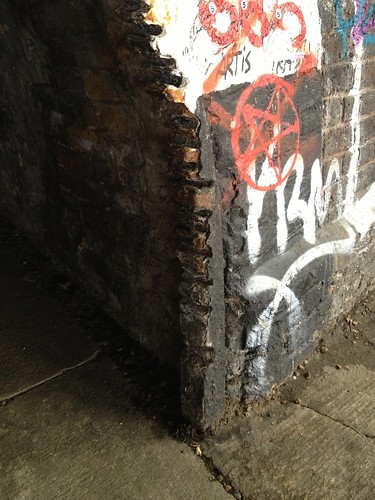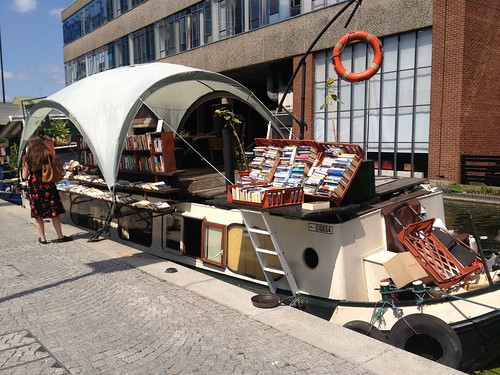“Believe me, my young friend, there is nothing - absolutely nothing - half so much worth doing as simply messing about in boats. Simply messing”
- Ratty to Mole, in The Wind in the Willows by Kenneth Grahame
I seem to have been spending a lot of time around water and boats these days. Obviously, Amsterdam was chock full of them, and I even went to the
Houseboat Museum there, which was tiny and charming. Closer to home, I recently re-visited the utterly fantastic curling bridge (
which I've blogged about before) in order to show it off to a friend who had never heard of it despite having moored his own boat right across from the bridge a week earlier. Lately it all seems to be about boats.
The houseboat museum interior
You might think that most of the messing about in boats that happens in London happens on the Thames, what with its international container port,
fabulous bridges, and ancient seafaring history dating back to, well, long past the beginning of dating. However, to confine London's boating scene to the river alone is to overlook the whole beguiling, charming, and sometimes well-hidden world of canals and canal boating.
Regent's Canal, near Camden Locks
Canals, of course, are man-made waterways mostly constructed for the movement of cargo on barges. Certainly you can move barges on rivers, but rivers have a habit of twisting inconveniently, or rushing over inhospitable precipices, or hiding big jaggedy rocks, or flooding, or running dry or, most importantly, NOT being where you want them to be in the first place. Hence for a few centuries, people have been creating canals. In the UK the first ones were built by... Who? Three guesses and the first two don't count... Yep. The Romans. Of course. But the Roman ones were mainly for irrigation. The first industrial canals were built in the mid sixteenth century. Sometimes canals are created by redirecting and taming existing rivers, but often it's simpler just to dig them where you want them. London is home to quite an extensive canal network, though Google has failed to deliver to me the actual total length of canals in the city, so let's just say more than 3 miles and less than 300 and move on.
Sensing that a canal blog was becoming inevitable, I nosed around a bit and discovered the
London Canal Museum. They offer a
downloadable walking tour of one section of the Regent's Canal, starting at Camden and ending at the museum near King's Cross. This seemed a perfect activity for a sunny Saturday morning, so off I went.
Here another key difference between canals and rivers. Rivers run; a river is constantly fed from its source with the water moving to its outlet. Canals, on the other hand, stand; a canal is a closed system with water supplied in a controlled fashion from an outside source at the top of the canal, usually a river or reservoir, and held in the canal by gates at the other end. And where natural rivers simply tumble down over changes in elevation, canals can't do that because then the water would all flood out over the gate at the other end. All canals are made up of flat level sections of water linked together with locks where the elevation changes. A lock is a set of gates that create a small chamber that allows you to let water in through the upstream gate to raise the boat in the chamber up to that level, or release the water through the downstream gate to lower the boat to that level. It's a simple and elegant solution, and the canals of London are dotted with locks at regular intervals.
Since you are reading this blog you are clearly of above-average intelligence, and I don't really need to explain how locks work, but I'm going to include this video of a rather condescending and shouty man anyways, because locks are inherently Clever Things, and we here at GSWPL World Headquarters are always happy to promote such things, especially if they might include GEARS. (Which canal gates do. Gears help open the trapdoors that allow water through the gates. Go gears!)
The locks on London canals are operated by hand, requiring the boater to operate the gate paddles and move the big gates themselves. And the gates are designed to meet at a mitre pointing upstream, so that the pressure of the higher water level on the opposite side pushes them tightly shut. (Incidentally, the mitre gate design was invented by Da Vinci. Clever boy.)
Before the railways, canals were the most efficient way of moving large volumes of cargo around the interior of England, and they became a key part of the Industrial Revolution because barges are especially well-suited for carrying the heavy cargo - coal, stone, gravel, timber, lime and cement - that fuelled the Industrial Revolution. And because this was before the advent of motorised transport, the barges were usually towed by horses. This is why canals always feature wide paths on one side or the other called towpaths. It's also why canals are so great for running along; towpaths are always dead flat, and it's pretty hard to get lost, because you can really only go in one of two directions.
The ropes used for towing used to get so saturated with abrasive mud that when horses pulled the barges around the corners of bridges they wore grooves in the iron coverings. See?
And here’s a temporary floating section of towpath near King’s Cross that's used because they’re doing building work on the towpath itself.
At one time families of bargemen lived aboard their barges in tiny little cabins at the stern of the barge. The most iconic type of barge is a narrowboat, so named because of its narrow beam ("beam" is the boaty word for width). A narrowboat is a bit less than 8 feet wide, but usually between 50 and 80 feet long. This means that even in narrow canals and locks, two narrowboats can usually pass by each other. (There are also wide beam boats that get up over 14 feet wide, but they're not as cool.) The canal museum houses part of a narrow barge, including the living quarters of the family that would have operated it They are decidedly cozy, even for me, a long time fan of tiny living spaces. Imagine housing a family of four in a space about the size of the bed of a quarter ton truck, with a ceiling about six feet high, half of which is filled with cabinetry and stoves and such. Suffice it to say that a bargeman would want to concentrate his spare time on hobbies like needlepoint or
carving scenes inside human hairs rather than, say, HO gauge model railroading or breeding Irish Wolfhounds.
The barge in the museum, showing the hatch into the living quarters
The advent of railways (and then trucking) effectively killed the industrial use of canals, and a lot of them were forgotten and fell into disrepair. However by the mid 20th century people began to see the potential for canals to be used for leisure and recreation. Holidaying on converted barges became popular, and gave local canal preservation societies the clout they needed to push for the refurbishment of England’s canals and locks. Now London's canals are bustling with small boats, kayaks, and people standing on those
ridiculous paddle board things, and the towpaths are full of walkers, cyclists, runners and the occasional rough sleeper in a tent tucked into the undergrowth. More interestingly, they're also home to about 15,000 people in the UK who
live aboard canal boats.
Today's narrowboats convert what used to be cargo space into living space and are often kitted out to quite a high standard with all the mod cons. Some stay at permanent moorings where they can plug into power and water supplies and access wifi and such, but others do what's called "continuous cruising" which is not actually continuous at all, because really it's usually long stretches of staying in one place, punctuated by brief periods of moving to another place. Depending on what part of what canal you're on, a continuous cruiser might be allowed to stay moored in one spot for up to two weeks, or might be required to move along in just a few days.
Boats moored outside the Canal Museum.
Popular mooring spots include an area near Paddington Basin, called Little Venice. It's a gorgeous spot close to the aforementioned magic bridge, and even has some charming local amenities, like a cafe on a narrowboat and the narrowboat book shop! There are also service barges that run up and down the canals delivering compressed gases, and pumping out septic tanks. And there are tugboats to haul you to the nearest service station when something goes wrong. There are even big scooper boats that go up and down skimming the inevitable layer of trash that accumulates on the water.
The book boat!
For someone like me, with a unfulfilled longing for her own living space in Central London and a desperate sense that owning something on dry land is a far distant dream, a narrowboat is a particularly alluring option. Never mind that my knowledge of diesel engines is confined to the notion that fuel goes in and (hopefully) a sort of chugging humming noise comes out. I’m sure I’d be fine… Also never mind that leaving a boat to swan off for an eight-month international gig may not be quite so simple as having your mail re-directed and remembering to get someone to feed the goldfish.*
Consider this ad that I saw for a live-aboard boat. A self-contained living space in Central London for under £20,000.
For now it's all just a dream, and my time messing around on boats is confined to boats owned by other people. Still... why not?
* This just in... Apparently it's actually quite easy and inexpensive to have your boat put safely into dry storage for extended periods.
Hmmmm...











1 Comment:
More use of your Russian!
Congrats on the new job.
Neat that you are getting to places that you didn't on your RTW trip. You are going to have one very interesting resume.
Post a Comment